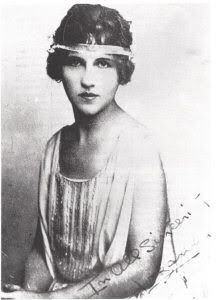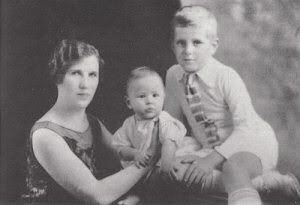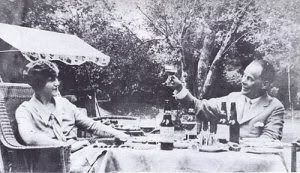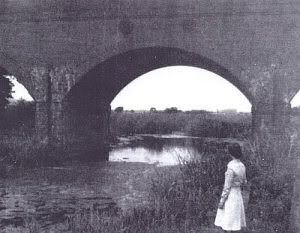| Bournemouth’s most sensational murder |
| The Rattenbury murder of 1935 is recalled by John Walker ( Dorset Life - The Dorset Magazine ) |
Francis Rattenbury at the peak of his success in British Columbia
In his book, Murder at the Villa Madeira, eminent lawyer-author Sir David Napley introduces the Rattenbury murder as follows: ‘The sensation of the year 1935 was the trial at the Old Bailey on charges of murder of Alma Rattenbury, an attractive woman of perhaps 39 or 40, and her lover, George Stoner, who had been employed in her house as a chauffeur-handyman.’ It was certainly the biggest local sensation in Bournemouth that year, and the biggest ever on its East Cliff. Although the murder in question took place in March 1935, our story really begins the previous September when the following advertisement appeared in the Bournemouth Daily Echo: ‘Daily willing lad, 14-18, for house-work; Scout-trained preferred. Apply between 11-12, 8-9 at 5 Manor Road, Bournemouth.’ 5 Manor Road on Bournemouth’s East Cliff was also known as the Villa Madeira. Five people were then resident in the house. They were 67-year-old retired architect Francis Mawson Rattenbury, his 39-year-old wife of ten years, Alma, her 13-year-old son by a previous marriage, Christopher, their own 6-year-old son, John, and Alma’s live-in companion-housekeeper, Irene Riggs. In November 1934 the ‘Daily willing lad’ who had answered the advertisement two months before and become the family’s chauffeur-handyman, 18-year-old George Stoner, also became a permanent resident. Sadly, nine months later, this ‘willing lad’ would be on trial at the Old Bailey for his very life.
A picture of Alma as Lozanne, her musical pen-name, may give an idea of why she attracted three husbands and at least one lover .
Francis Mawson Rattenbury, Yorkshire born and bred, sailed from England to Canada in 1892 at the age of 24 to seek his fame and fortune as an architect in the developing area of British Columbia. He was not to be disappointed. Within a year he had won an open competition to design the Parliament Buildings for Victoria, the town selected as British Columbia’s capital. The resulting edifice met with widespread approval and he came to be in great demand. His later work included the Law Courts in Vancouver and the luxurious Empress Hotel on Victoria’s waterfront, a venue that would play a pivotal role in his private life. In between these successes, Francis led a roller-coaster life. Often ruthless and aggressive in dealing with others, he received little sympathy when failed private business ventures left him short of funds with only his architectural talent to fall back on. To make matters worse, on 29 December 1923, while celebrating the award of an important local contract in ‘his’ Empress Hotel, the 56-year-old Rattenbury met and fell in love with Alma Pakenham, a divorcée half his age. Once their affair became public knowledge, Rattenbury then married with two children and considered a pillar of local society, was no longer welcome in Victoria. An acrimonious divorce followed and the newly-weds, together with Alma’s son, Christopher Pakenham, finally settled in Manor Road on Bournemouth's East Cliff.
Alma with John and Christopher
Alma herself grew up in British Columbia. In her teenage years she lived in Vancouver and, with her mother’s guidance, became an accomplished musician, something she was able to fall back on in later years. At 19 she married the love of her life, Ulsterman Caledon Dolling, and followed him to England when he enlisted in the Army in World War I. On receiving the tragic news that Dolling had been killed at the Battle of the Somme, Alma immediately joined a Scottish ambulance unit that she knew would be working behind the French lines. Her bravery in this situation led to her being awarded a leading French medal, the Croix de Guerre with Star and Palm. At the end of World War I, she married Captain Compton Pakenham and moved with him to America. Following the birth of Christopher, the marriage broke up and she and her son joined her mother in Vancouver. Alma returned to music professionally and one day, after performing in Victoria, found herself enjoying a relaxing drink at the Empress Hotel with a friend; it was 29 December 1923. When she married Rattenbury in 1925 at the age of 29, the now thrice-married Alma had borne one son (Christopher), been cited as co-respondent in two divorce cases (Pakenham’s and Rattenbury’s), enjoyed fame as a musician and received a top French military honour. Quite a life so far! By contrast, the third member of our trio, 18-year-old George Stoner, was rather shy and retiring, having been rather a loner as a child with no serious girl-friends. His time had been spent between the family home in Redhill, Bournemouth and his grandparents’ house in Ensbury Park, Bournemouth. A handsome lad, the fact that he could drive and thus work as a chauffeur-handyman was a big plus to the Rattenburys when they employed him in September 1934. Two months later he was living in at the Villa Madeira and embarking on a passionate affair with Alma Rattenbury. Because of their respective backgrounds and ages, it must be assumed that Alma was very much the instigator.
George Stoner
By November 1934 Francis Rattenbury was often depressed and suicidal. Now impotent – he and Alma had not had sexual relations since the birth of John – he took refuge in a nightly bottle of whisky. He slept on his own downstairs and appears not to have objected to his wife’s affair; in such a small house it is almost inconceivable that he did not know what was going on. For her part, Alma, still attractive and hoping to enhance her blossoming career as a songwriter, was caught in a dreary domestic situation. The affair continued for a few months, with Stoner visiting Alma’s bedroom at night. As time went on, however, the formerly shy Stoner, quite unnecessarily, became increasingly aggressive and possessive of Alma, expressing jealousy whenever she and Francis spent time together. Matters came to a head over the weekend of 23/24 March 1935, just after Alma and Stoner returned from a trip to London. Francis was particularly depressed and to cheer him up, Alma organised for them to visit a friend in Bridport the following week. On the afternoon of 24 March, Stoner had borrowed a wooden mallet from his grandparents in Ensbury Park, supposedly to erect a screen in the garden. Later that evening, Francis was found seriously injured, bludgeoned with a weapon that turned out to be the same mallet. It was not until doctors had taken Francis to hospital for examination and wiped the matted blood away from his head that they realised foul play had taken place and informed the police.
Alma and Francis in happier days
It was therefore the early hours of Monday morning before the police arrived at the Villa Madeira, by which time Alma was very much the worse for wear through drink or drugs and kept repeating that she had ‘done him in’. She repeated that same story the following morning and was arrested for attempted murder, Francis being still alive at this time. Two days later, Stoner confessed to companion-housekeeper Irene Riggs that he had done the deed and he was also arrested. On the Thursday, Francis Rattenbury died of his injuries and the charges became ones of murder. Alma Rattenbury and George Stoner were tried together at the Old Bailey on 27 May 1935, there being far too much local interest for the case to be heard at Winchester. By this time both defendants had been persuaded to plead not guilty. Stoner refused to say anything at the trial other than answer to his name, while Alma put up a robust defence. Four days later, Stoner was found guilty of murder and sentenced to death and Alma was released. It does seem likely that he was the only one involved. A possible explanation is that in a jealous rage, he had only intended to harm Francis enough to stop the proposed visit to Bridport rather than to murder him. Public sympathy was with the convicted Stoner, led astray by a much older woman, and a haggard-looking Alma was booed by a large crowd as she left the Old Bailey. A few days later, she took the train from Waterloo to Christchurch and walked across the meadows to Three Arches railway bridge, which spans a tributary of the River Avon. After writing some notes on the bankside, she walked towards the water and, plunging a knife several times into her heart, died almost immediately. It is clear from the notes and from the words of a song she wrote while awaiting trial – subsequently published as ‘Mrs Rattenbury's Prison Song’ – that she really did love Stoner, who she thought was soon to be hanged. She had died of shame. Stoner, when informed of her death, broke down and cried. At Alma’s funeral and burial at Bournemouth’s Wimborne Road Cemetery, a few yards from where her late husband lay, signatures were already being collected for mercy for the ‘led astray’ Stoner. A petition containing an amazing 320,000 signatures, including those of the local Mayor and MP, was later handed in to the Home Secretary, who commuted Stoner’s sentence to penal servitude for life. A model prisoner, he was released seven years later in 1942, then joined the Army for the remainder of World War 2. He returned to live the rest of his life in the house in Redhill he had left at the age of 18. He died in Christchurch Hospital in 2000 aged 83, not much more that half a mile from where Alma perished and on exactly the 65th anniversary of Francis’s murder! Despite all this drama, the two boys innocently caught up in the case both went on to lead happy family lives and have successful professional careers. The only person still alive today from the whole sorry saga is John Rattenbury, now 77 and a successful architect (like his father) in America.
Three Arches, where Alma committed suicide







No comments:
Post a Comment